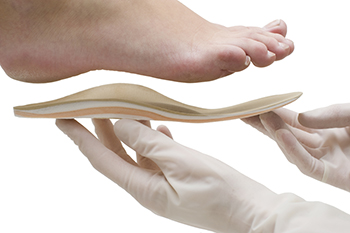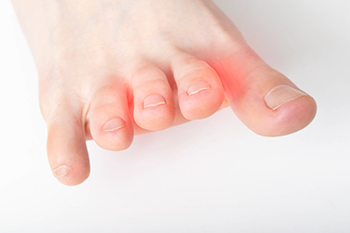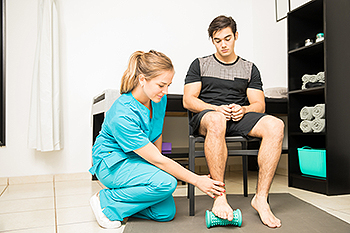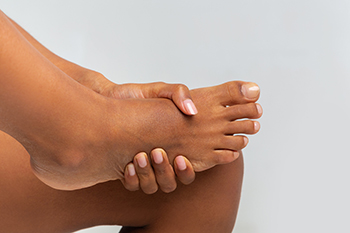Garner (919) 661-4150
July 2022
Does Your Child Need Orthotics?

As a child grows and navigates their way through their youth, they may experience any number of foot problems. For example, your child may complain to you about having foot pain as a result of having flat feet. Consequently, your child might have sunken arches in their feet and turn their feet inward when walking. One important way in which you might be able to help improve the condition of your child’s feet is with orthotics. These custom-made shoe inserts can be made to exactly fit your child’s specific foot, and are made to help correct their gait. Namely, orthotics for children with flat feet are designed to have arch support cushions that encourage their feet not to collapse into the ground when walking. Additionally, orthotics for children with flat feet also have heel cushions that are intended to strengthen the ankles. These shoe inserts can be utilized in many different kinds of spacious footwear for children. Orthotics are not just for children – they have been effective in correcting the gaits of individuals of all ages as well. When it comes to protecting the health of your child’s feet, it is best not to take chances and to be proactive in preventing injuries. It is highly suggested to see a podiatrist for more information about orthotics.
If you are having discomfort in your feet and would like to try orthotics, contact Chukwuma Ukata, DPM from Advanced Carolina Foot and Ankle Center. Our doctor can provide the care you need to keep you pain-free and on your feet.
What Are Orthotics?
Orthotics are inserts you can place into your shoes to help with a variety of foot problems such as flat feet or foot pain. Orthotics provide relief and comfort for minor foot and heel pain but can’t correct serious biomechanical problems in your feet.
Over-the-Counter Inserts
Orthotics come in a wide variety of over-the-counter inserts that are used to treat foot pain, heel pain, and minor problems. For example, arch supports can be inserted into your shoes to help correct overarched or flat feet, while gel insoles are often used because they provide comfort and relief from foot and heel pain by alleviating pressure.
Prescription Orthotics
If over-the-counter inserts don’t work for you or if you have a more severe foot concern, it is possible to have your podiatrist prescribe custom orthotics. These high-quality inserts are designed to treat problems such as abnormal motion, plantar fasciitis, and severe forms of heel pain. They can even be used to help patients suffering from diabetes by treating foot ulcers and painful calluses and are usually molded to your feet individually, which allows them to provide full support and comfort.
If you are experiencing minor to severe foot or heel pain, it’s recommended to speak with your podiatrist about the possibilities of using orthotics. A podiatrist can determine which type of orthotic is right for you and allow you to take the first steps towards being pain-free.
If you have any questions please contact our office located in Garner, NC . We offer the newest diagnostic and treatment technologies for all your foot and ankle needs.
Do Your Child's Feet Hurt?
Relief Options for Mild and Severe Cases of Morton’s Neuroma

The medical term for the foot condition known as Morton’s neuroma is Morton’s metatarsalgia or interdigital neuroma. It is an ailment that affects the area between the third and fourth toes, and is quite painful. The pain is often felt in the ball of the foot and between the toes. It occurs as a result of a nerve that thickens between the toes, and can happen from wearing shoes that do not have adequate room for the toes to move freely in. High heels generally fit into this category. Additionally, people who participate in high-impact physical activities that consist of running and jumping may be affected. Many patients with Morton's neuroma experience severe pain and find it difficult to walk. It may begin with a tingling or numbing sensation, and may gradually develop into a shooting pain. It can be likened to walking with a pebble or marble in the shoe. In mild cases, relief may come from implementing simple lifestyle changes, such as wearing comfortable shoes and refraining from running and jumping. Surgery that can reset the nerve may be an option in severe cases. If you have this type of foot pain, please consult with a podiatrist who can properly diagnose and treat Morton’s neuroma.
Morton’s neuroma is a very uncomfortable condition to live with. If you think you have Morton’s neuroma, contact Chukwuma Ukata, DPM of Advanced Carolina Foot and Ankle Center. Our doctor will attend to all of your foot care needs and answer any of your related questions.
Morton’s Neuroma
Morton's neuroma is a painful foot condition that commonly affects the areas between the second and third or third and fourth toe, although other areas of the foot are also susceptible. Morton’s neuroma is caused by an inflamed nerve in the foot that is being squeezed and aggravated by surrounding bones.
What Increases the Chances of Having Morton’s Neuroma?
- Ill-fitting high heels or shoes that add pressure to the toe or foot
- Jogging, running or any sport that involves constant impact to the foot
- Flat feet, bunions, and any other foot deformities
Morton’s neuroma is a very treatable condition. Orthotics and shoe inserts can often be used to alleviate the pain on the forefront of the feet. In more severe cases, corticosteroids can also be prescribed. In order to figure out the best treatment for your neuroma, it’s recommended to seek the care of a podiatrist who can diagnose your condition and provide different treatment options.
If you have any questions, please feel free to contact our office located in Garner, NC . We offer the newest diagnostic and treatment technologies for all your foot care needs.
What Is a Plantar Fibroma?

A plantar fibroma is a benign, noncancerous, growth that is less than one inch in size and develops in the arch of the foot. It grows in the plantar fascia, the thick, fibrous tissue that runs across the bottom of the foot and stabilizes the foot arch. A plantar fibroma can develop on one or both feet. Anyone can develop a plantar fibroma, but it is most apt to occur in young or middle-aged adults and males. This growth appears on the bottom of the foot in the middle of the arch. It is characterized by small bumps that can be painless at first but become painful as the nodules grow larger. Since there is no known cause of a plantar fibroma, there is no way to prevent it. If you suspect you have a plantar fibroma, consult with a podiatrist who can make a diagnosis and provide treatment for it, or any other foot or ankle condition found.
A plantar fibroma may disrupt your daily activities. If you have any concerns, contact Chukwuma Ukata, DPM of Advanced Carolina Foot and Ankle Center. Our doctor can provide the care you need to keep you pain-free and on your feet.
Plantar Fibroma
A plantar fibroma is a fibrous knot in the arch of the foot. It is embedded in the plantar fascia which is a band of tissue that extends from the heel to the toes along the bottom of the foot. There can be multiple plantar fibromas in the feet at the same time. There are no known causes for this condition. If you have a plantar fibroma, there will be a bump in the arch of your foot that cannot be missed. Any associated pain is most often due to a shoe rubbing against the nodule. Non-surgical options, such as steroid injections, physical therapy, and orthotics should be tried first. Surgery is a last resort and is the only thing that will remove a plantar fibroma entirely. Consult with a podiatrist for a proper diagnosis and to determine the treatment regimen that is right for you.
What Causes a Plantar Fibroma?
While there are no specific causes identified, a plantar fibroma can possibly come from genetic predisposition or the formation of scar tissue that forms from healing the tears in the plantar fascia.
What Are the Symptoms of a Plantar Fibroma?
There will be a noticeable lump in the arch of the foot that may or may not cause pain. If pain is felt, it is typically because a shoe is rubbing up against the lump or when walking or standing barefoot.
Treatment and Prevention
A plantar fibroma will not disappear without treatment, but it can get smaller and be a non-issue. If pain persists, a podiatrist examines the foot and when the arch of the foot is pressed, pain can be felt down to the toes. An MRI or biopsy might be performed to help diagnose or evaluate the plantar fibroma. The following non-surgical options are generally enough to reduce the size and pain of these nodules:
- Steroid injections
- Orthotics
- Physical therapy to help apply anti-inflammatory creams on the bump
Surgery is considered if the mass increases in size and the patient continues to feel pain after non-surgical methods are tried.
If you have any questions please feel free to contact our office located in Garner, NC . We offer the newest diagnostic tools and technology to treat your foot and ankle needs.
What Can Cause Tarsal Tunnel Syndrome?

The tarsal tunnel is an important part of foot function. When one of the nerves inside the tarsal tunnel becomes compressed, tarsal tunnel syndrome can develop. This can happen as a result of a fracture, bone spur, or foot deformity. A common symptom that is associated with this condition can include a burning and tingling sensation in the bottom of the foot and heel. Additionally, some patients notice shooting pain in one or more spots in the foot. An effective diagnosis can include having the Tinels’ Test performed, which consists of tapping on the nerve as it passes through the tunnel. Patients can find mild relief when the correct footwear is worn, and orthotics may be needed for additional support. Tarsal tunnel syndrome is treated by a podiatrist, and it is strongly suggested that if you have these symptoms, an appointment is scheduled as quickly as possible.
Tarsal tunnel syndrome can be very uncomfortable to live with. If you are experiencing tarsal tunnel syndrome, contact Chukwuma Ukata, DPM of Advanced Carolina Foot and Ankle Center. Our doctor can provide the care you need to keep you pain-free and on your feet.
Tarsal Tunnel Syndrome
Tarsal tunnel syndrome, which can also be called tibial nerve dysfunction, is an uncommon condition of misfiring peripheral nerves in the foot. The tibial nerve is the peripheral nerve in the leg responsible for sensation and movement of the foot and calf muscles. In tarsal tunnel syndrome, the tibial nerve is damaged, causing problems with movement and feeling in the foot of the affected leg.
Common Cause of Tarsal Tunnel Syndrome
- Involves pressure or an injury, direct pressure on the tibial nerve for an extended period of time, sometimes caused by other body structures close by or near the knee.
- Diseases that damage nerves, including diabetes, may cause tarsal tunnel syndrome.
- At times, tarsal tunnel syndrome can appear without an obvious cause in some cases.
The Effects of Tarsal Tunnel Syndrome
- Different sensations, an afflicted person may experience pain, tingling, burning or other unusual sensations in the foot of the affected leg.
- The foot muscles, toes and ankle become weaker, and curling your toes or flexing your foot can become difficult.
- If condition worsens, infections and ulcers may develop on the foot that is experiencing the syndrome.
A physical exam of the leg can help identify the presence of tarsal tunnel syndrome. Medical tests, such as a nerve biopsy, are also used to diagnose the condition. Patients may receive physical therapy and prescriptive medication. In extreme cases, some may require surgery.
If you have any questions please feel free to contact our office located in Garner, NC . We offer the newest diagnostic and treatment technologies for all your foot and ankle needs.







